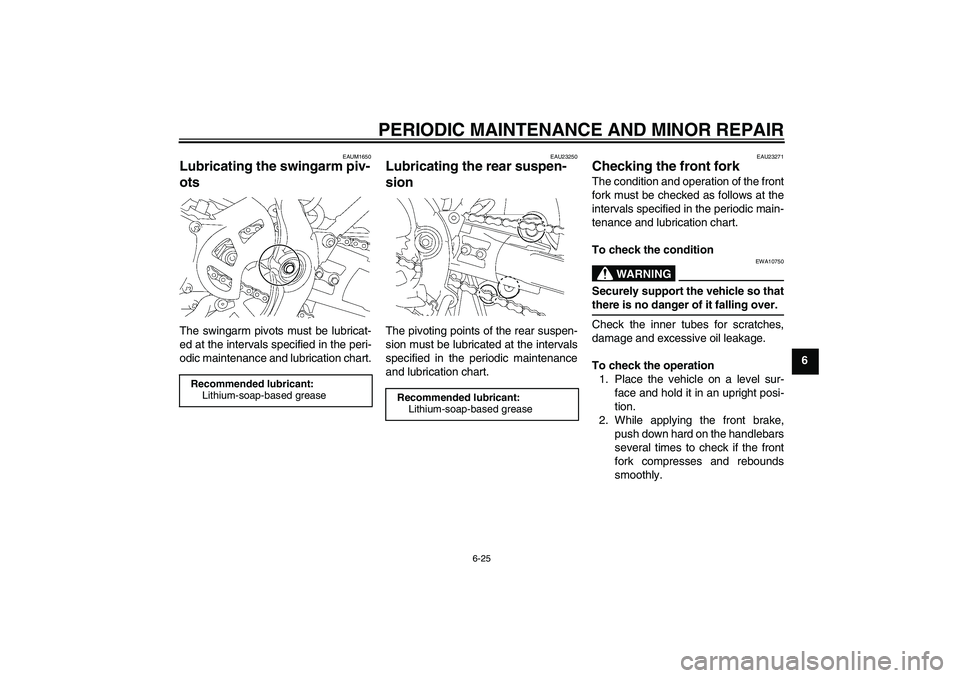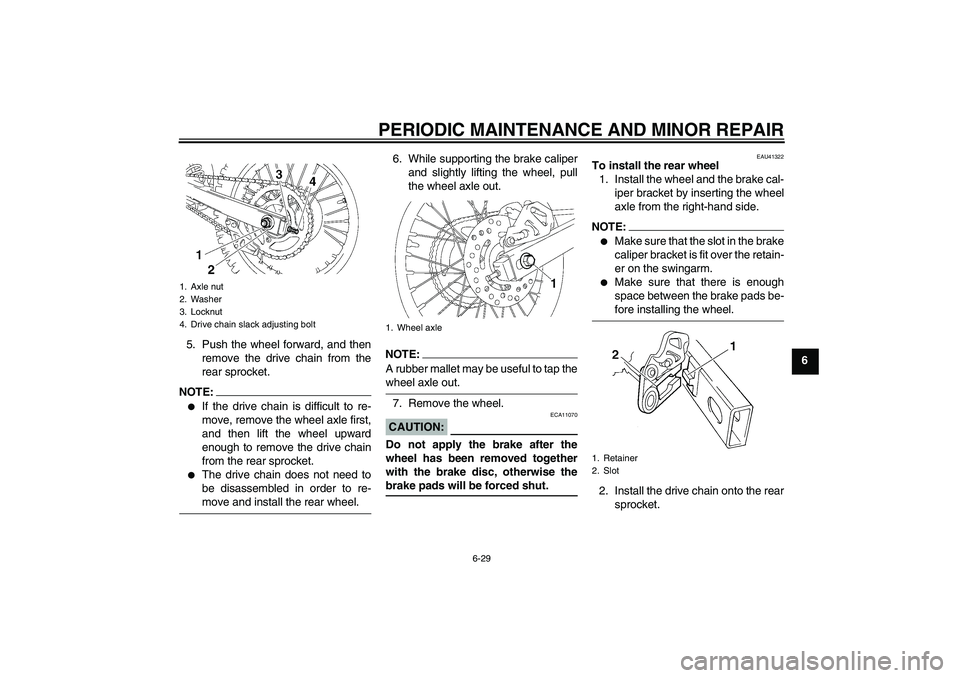Page 65 of 82

PERIODIC MAINTENANCE AND MINOR REPAIR
6-25
6
EAUM1650
Lubricating the swingarm piv-
ots The swingarm pivots must be lubricat-
ed at the intervals specified in the peri-
odic maintenance and lubrication chart.
EAU23250
Lubricating the rear suspen-
sion The pivoting points of the rear suspen-
sion must be lubricated at the intervals
specified in the periodic maintenance
and lubrication chart.
EAU23271
Checking the front fork The condition and operation of the front
fork must be checked as follows at the
intervals specified in the periodic main-
tenance and lubrication chart.
To check the condition
WARNING
EWA10750
Securely support the vehicle so thatthere is no danger of it falling over.
Check the inner tubes for scratches,
damage and excessive oil leakage.
To check the operation
1. Place the vehicle on a level sur-
face and hold it in an upright posi-
tion.
2. While applying the front brake,
push down hard on the handlebars
several times to check if the front
fork compresses and rebounds
smoothly.
Recommended lubricant:
Lithium-soap-based grease
Recommended lubricant:
Lithium-soap-based grease
U5PA86E0.book Page 25 Monday, April 9, 2007 3:16 PM
Page 66 of 82
PERIODIC MAINTENANCE AND MINOR REPAIR
6-26
6
CAUTION:
ECA10590
If any damage is found or the front
fork does not operate smoothly,
have a Yamaha dealer check or re-pair it.
EAU23280
Checking the steering Worn or loose steering bearings may
cause danger. Therefore, the operation
of the steering must be checked as fol-
lows at the intervals specified in the pe-
riodic maintenance and lubrication
chart.
1. Place a stand under the engine to
raise the front wheel off the
ground.
WARNING
EWA10750
Securely support the vehicle so thatthere is no danger of it falling over.
2. Hold the lower ends of the front
fork legs and try to move them for-
ward and backward. If any free
play can be felt, have a Yamaha
dealer check or repair the steering.
U5PA86E0.book Page 26 Monday, April 9, 2007 3:16 PM
Page 67 of 82

PERIODIC MAINTENANCE AND MINOR REPAIR
6-27
6
EAU23290
Checking the wheel bearings The front and rear wheel bearings must
be checked at the intervals specified in
the periodic maintenance and lubrica-
tion chart. If there is play in the wheel
hub or if the wheel does not turn
smoothly, have a Yamaha dealer check
the wheel bearings.
EAU24350
Supporting the motorcycle Since this model is not equipped with a
centerstand, follow these precautions
when removing the front and rear
wheel or performing other maintenance
requiring the motorcycle to stand up-
right. Check that the motorcycle is in a
stable and level position before starting
any maintenance. A strong wooden
box can be placed under the engine for
added stability.
To service the front wheel
1. Stabilize the rear of the motorcycle
by using a motorcycle stand or, if
an additional motorcycle stand is
not available, by placing a jack un-
der the frame in front of the rear
wheel.
2. Raise the front wheel off the
ground by using a motorcycle
stand.
To service the rear wheel
Raise the rear wheel off the ground by
using a motorcycle stand or, if a motor-
cycle stand is not available, by placinga jack either under each side of the
frame in front of the rear wheel or under
each side of the swingarm.
U5PA86E0.book Page 27 Monday, April 9, 2007 3:16 PM
Page 68 of 82

PERIODIC MAINTENANCE AND MINOR REPAIR
6-28
6
EAU24360
Front wheel
EAU41340
To remove the front wheel
WARNING
EWA10820
�
It is advisable to have a Yamaha
dealer service the wheel.
�
Securely support the motor-
cycle so that there is no dangerof it falling over.
1. Loosen the axle nut.
2. Lift the front wheel off the ground
according to the procedure on
page 6-27.
3. Remove the axle nut and washer.4. Pull the wheel axle out, and then
remove the wheel.
EAU41420
To install the front wheel
1. Lift the wheel up between the fork
legs.
2. Insert the wheel axle from the right
side.
3. Lower the front wheel so that it is
on the ground.
4. Install the washer and axle nut,
and then tighten the axle nut to the
specified torque.
EAU25080
Rear wheel
EAU41311
To remove the rear wheel
WARNING
EWA10820
�
It is advisable to have a Yamaha
dealer service the wheel.
�
Securely support the motor-
cycle so that there is no dangerof it falling over.
1. Loosen the axle nut.
2. Lift the rear wheel off the ground
according to the procedure on
page 6-27.
3. Loosen the locknut and drive chain
adjusting bolt on each side of the
swingarm.
4. Remove the axle nut and washer.
1. Washer
2. Axle nut
1. Wheel axleTightening torque:
Axle nut:
70 Nm (7.0 m·kgf, 50 ft·lbf)
U5PA86E0.book Page 28 Monday, April 9, 2007 3:16 PM
Page 69 of 82

PERIODIC MAINTENANCE AND MINOR REPAIR
6-29
6 5. Push the wheel forward, and then
remove the drive chain from the
rear sprocket.
NOTE:�
If the drive chain is difficult to re-
move, remove the wheel axle first,
and then lift the wheel upward
enough to remove the drive chain
from the rear sprocket.
�
The drive chain does not need to
be disassembled in order to re-move and install the rear wheel.6. While supporting the brake caliper
and slightly lifting the wheel, pull
the wheel axle out.
NOTE:
A rubber mallet may be useful to tap thewheel axle out.
7. Remove the wheel.CAUTION:
ECA11070
Do not apply the brake after the
wheel has been removed together
with the brake disc, otherwise thebrake pads will be forced shut.
EAU41322
To install the rear wheel
1. Install the wheel and the brake cal-
iper bracket by inserting the wheel
axle from the right-hand side.NOTE:�
Make sure that the slot in the brake
caliper bracket is fit over the retain-
er on the swingarm.
�
Make sure that there is enough
space between the brake pads be-fore installing the wheel.
2. Install the drive chain onto the rear
sprocket.
1. Axle nut
2. Washer
3. Locknut
4. Drive chain slack adjusting bolt
1. Wheel axle
1. Retainer
2. Slot
U5PA86E0.book Page 29 Monday, April 9, 2007 3:16 PM
Page 70 of 82

PERIODIC MAINTENANCE AND MINOR REPAIR
6-30
63. Install the washer and axle nut,
and then lower the rear wheel so
that it is on the ground.
4. Adjust the drive chain slack. (See
page 6-21.)
5. Tighten the axle nut to the speci-
fied torque.
EAU25870
Troubleshooting Although Yamaha motorcycles receive
a thorough inspection before shipment
from the factory, trouble may occur dur-
ing operation. Any problem in the fuel,
compression, or ignition systems, for
example, can cause poor starting and
loss of power.
The following troubleshooting charts
represent quick and easy procedures
for checking these vital systems your-
self. However, should your motorcycle
require any repair, take it to a Yamaha
dealer, whose skilled technicians have
the necessary tools, experience, and
know-how to service the motorcycle
properly.
Use only genuine Yamaha replace-
ment parts. Imitation parts may look like
Yamaha parts, but they are often inferi-
or, have a shorter service life and can
lead to expensive repair bills.
Tightening torque:
Axle nut:
90 Nm (9.0 m·kgf, 65 ft·lbf)
U5PA86E0.book Page 30 Monday, April 9, 2007 3:16 PM
Page 71 of 82
PERIODIC MAINTENANCE AND MINOR REPAIR
6-31
6
EAU41491
Troubleshooting charts Starting problems or poor engine performance
WARNING
EWA10840
Keep away open flames and do not smoke while checking or working on the fuel system.
Check the fuel level in
the fuel tank.1. Fuel
There is
enough fuel.
There is
no fuel.
Supply fuel.
Operate the kickstarter.2. Compression
There is compression.
There is
no compression.Check the ignition.
Have a Yamaha dealer
check the vehicle.
Remove the spark plug
and check the electrodes.3. Ignition
Wet
DryWipe off with a dry cloth and correct the
spark plug gap, or replace the spark plug.
Have a Yamaha dealer check the vehicle.The engine does not start.
Have a Yamaha dealer check the vehicle.
Open the throttle halfway and operate
the kickstarter.
Check the compression.
The engine does not start.
Check the compression.
U5PA86E0.book Page 31 Monday, April 9, 2007 3:16 PM
Page 72 of 82

PERIODIC MAINTENANCE AND MINOR REPAIR
6-32
6Engine overheating
WARNING
EWAT1040
�
Do not remove the radiator cap when the engine and radiator are hot. Scalding hot fluid and steam may be
blown out under pressure, which could cause serious injury. Be sure to wait until the engine has cooled.
�
Place a thick rag, like a towel, over the radiator cap, and then slowly rotate the cap counterclockwise to the de-
tent to allow any residual pressure to escape. When the hissing sound has stopped, press down on the capwhile turning it counterclockwise, and then remove the cap.
NOTE:If coolant is not available, tap water can be temporarily used instead, provided that it is changed to the recommended coolantas soon as possible.
Wait until the
engine has cooled.
Check the coolant level in the
radiator.
The coolant level
is OK.The coolant level is low.
Check the cooling system
for leakage.
Have a Yamaha dealer checkand repair the cooling system.Add coolant. (See NOTE.)
Start the engine. If the engine overheats again,
have a
Yamaha dealer check
and repair the cooling system.
There is
leakage.
There is
no leakage.
U5PA86E0.book Page 32 Monday, April 9, 2007 3:16 PM